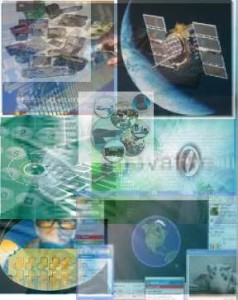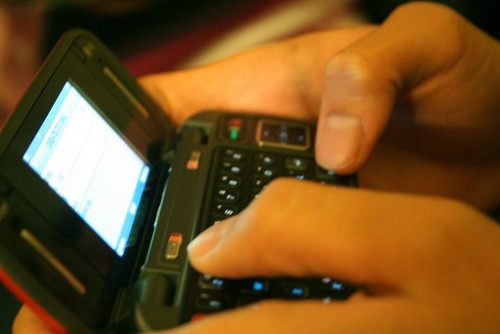Upon reflection…
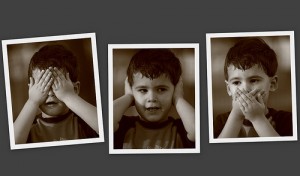
See No Evil, Hear No Evil, Speak no Evil
Why this picture you ask? I guess it’s because I feel this proverb epitomizes the changing nature of text and technology and the fact that it’s not something we can or should ignore.
I want to begin by saying that it’s taking a while for me to get use to using this type of forum. As day passes, I believe I’m getting a little better at navigating and contributing to our weblog. I must say I was a little skeptical at first, perhaps because I’m more ‘old school’ and more comfortable using older technologies. That being said, I’m always up for a challenge and this certainly seems to be pushing me to the max. It helps knowing that I’m not the only one that’s struggling on the technology side of things. The bottom line is that I’m learning plenty of new and interesting things.
I was surprised to learn in Module 1 that there were so many different definitions for text and technology and that these terms are used in so many different contexts. I’m used to be surrounded by books but in more recent years, I find myself spending more time working from a computer. I’m not a gamer but I can see the attraction. I think the internet is a wonderful thing and I use it for many reasons, everything from communicating to family and friends, to finding out information on just about anything. I believe that, as a technology, the internet is responsible for transforming the way we see and use text. I don’t know if that’s a good thing or a bad thing.
After I listened to O’Donnell’s From Papyrus to Cyberspace and reviewed the discussion postings on the text and technology, I couldn’t help but wonder what lies ahead. I think it might be interesting to listen to what people are prophesying about today, particularly with respect to where they believe the technology is expected to go but also about how they think it will alter the way we view text. Based on the Papyrus to Cyberspace experience, we shouldn’t be surprised to learn that some of what is said will come to pass. We should also expect the unexpected as it is almost impossible to predict with certainly, just how things will unfold. As with most things in life, what we think will happen and what actually happened are usually two different things.
If I could rewrite my first impressions on text and technology I suspect the entries would quite different than what they are now. I can’t say I would have changed what I wrote previously. Instead, I would probably have expanded it to include all the other things I hadn’t thought of previously or hadn’t known until now. Perhaps it would be worthwhile to reflect on these two terms again, towards the end of the course.
Bruce
September 25, 2009 No Comments
Technology as a way of revealing
I noticed that Rich had already posted a passage from Heidegger and “The Question Concerning Technology”, but I would like to discuss another part of it. Early in this essay Heidegger states that “Technology is a way of revealing”. I think that this is important and that the “revealing” Heidegger mentions is closely connected with what he elsewhere calls “regioning”, which he says opens “the clearing of Being”. By this he does not mean a type of conscious thought or unconscious thought but rather something that makes both of these possible to begin with. It is tied up with speaking a language and with dwelling among other people in the world. (He gets rather mystical when he tries to describe it in his later writings.) The view of technology as a way of revealing would suggest that technology is inextricably bound up with the way in which we live, our practices, and our institutions. It would support Neil Postman’s claim that a technology’s function follows from its form and that new technologies threaten institutions. It may be a bit disturbing, though, as we usually like to think of ourselves as rational beings who can represent technology objectively and freely decide how we will use it. As Heidegger himself explains at the end of the essay, though, it is not necessarily a fatalistic picture.
September 24, 2009 No Comments
Technology
My thoughts on technology…
References:
Suction Tool. Digital image. Flickr. 1 July 2007. Web. 16 Sept. 2009. .
technology. (2009). In Merriam-Webster Online Dictionary.
Retrieved September 16, 2009, from http://www.merriam-webster.com/dictionary/technology
September 19, 2009 No Comments
The Art of Text
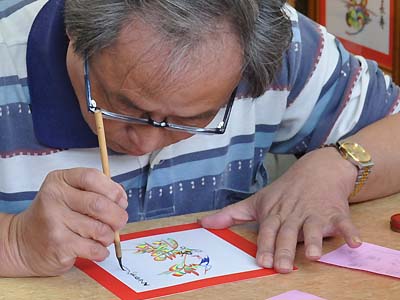
Coming from a design background, I have come to see text as an art form that is often manipulated as content or as part of a layout and for me, that is usually how I intermingle text with technology. Text is no longer a static form but it can also be animated. Looking back at the origins of text in its more static form, some examples of text as an artistic, symbolic form is its use in hieroglyphs and asian characters. Technology works to, in some form, mechanize the text through writing tools, printers and other text-making tools.
One mingling of text and technology that came to mind is the use of calligraphic tools not just for communication but as an art form. In Asia, the calligraphic brush was more widely used in the past to paint characters in languages. When painted, the symbols have flowing strokes and lines, with some strokes more emphasized than others. Today, those same characters in print have been “mechanized” and converted into harsh lines and strokes that are even throughout. The same can be said for handwriting.
What are the implications of text and technology today: How much have computers created a kind of convenience in the way we communicate and will handwritten texts still exist in the future? In the last 10 years alone, I think technology has done a great deal in changing the way we look at and learn how to use text using computers, cell phones and other, more advanced non-traditional devices.
Marjorie
September 18, 2009 2 Comments
Nailing Down Technology
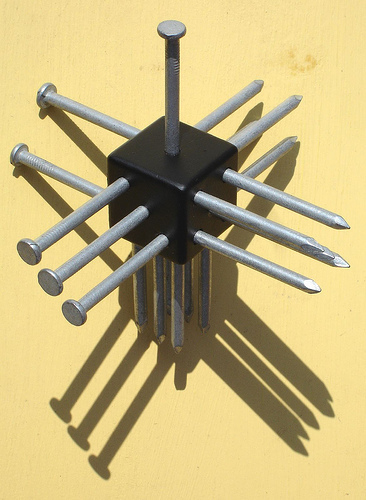
“Technology” is almost as broad of a term as “text,” however; in the context of ETEC540, it’s a little easier to nail down. My new understanding of these two concepts is that they clearly have something fundamental in common. They are clearly both SYSTEMS. Examining them together has helped me see this significant overlap. Could we have “text” without “technology?” No, because text is a technology of communication. Could we have “technology” without “text?”
September 17, 2009 1 Comment
Technological System…

Web 2.0, originally uploaded by Rod Monkey.
“Technology is a system. It entails far more than its individual material components. Technology involves organization, procedures, symbols, new words, equations, and, most of all, a mindset.” (Franklin, p. 2-3)
Technology is more commonly perceived as any human-made object that does not occur naturally in nature, but often imitates more naturally occurring phenomena, and are often used to aid us in some fashion.
However, technology is ecological in that it doesn’t just add or subtract; as Postman puts it, “it changes everything” (Postman, 1992, p. 18). The printing press revolutionized our access to knowledge. Internet has changed our communications patterns.
Thus, technology is a system, inextricably linked to human life.
Hermia
References:
Franklin, U. (1999). The Real World of Technology. Toronto: Anansi.
Postman, N. (1992). Technopoly: the surrender of culture to technology. New York: Vintage Books.
September 15, 2009 No Comments
Technology is….

Balance Prime
The word technology is something that I struggle with often. I see technology as any tool that aids in the creation of some other object or allows work to be completed with some amount of ease. Consider a rock. If I use a rock to hit another person, it is now a weapon. If I use a rock to draw a picture on a cave wall, it is a tool. My perfered definition of technology is best described by Ursula Franklin in the CBC Massey Lectures. Franklin states “Like democracy, technology is a multifaceted entity. It includes activities as well as a body of knowledge, structures as well as the act of structuring.” (Franklin, 1999, p. 6) Franklin further defines technology as “practice…ways of doing something.” ((p.6) This ‘process of work’ can be categorized into two distinct spheres including holistic and prescriptive technologies. Holistic technologies can be equated to those events whereby the same individual envisions an idea, prepares the means to accomplish the idea, and results in an end product that was created from start to finish by one set of hands; a painting, a goblet, or writing on a cave wall. Prescriptive technologies can be best summed up by mass production, compliance to a standard and little to no deviation or creativity for the worker; Fordism or Military training
Franklin, Ursula. (1999) The Real World of Technology. (CBC Massey lectures series.) Concord, ON: House of Anansi Press Limited.
September 15, 2009 No Comments
What is technology?
When I think of technology, I’m reminded of the many years I worked as a technical writer learning about and documenting many telecommunications’ technologies: Creating conceptual and procedural information to accompany complex telecommunications equipment. I’m also reminded of the fact that technology speaks to me as being something that’s supposed to make our lives easier, better, and is very important. Its importance is described by Postman: ” Technology imperiously commandeers our most important terminology. It redefines freedom, truth, intelligence, fact, wisdom, memory, history, all the words we live by. (Postman, 1992 pp.8-9)
Postman, N (1992). Technopoly: The surrender of culture to technology. New York:Vintage Books.
September 15, 2009 No Comments
Technology OED style
“OED was built up from the contributions of thousands of amateur philologists all over England and, later, the world.” (vista ETEC 540 sept09). Well in the style of the OED I google images with the search criteria “technology.” If google is understood as access to a collective intelligence of the web (to find out more) than the images it produces could be understood as a collective understanding of technology as an image. After searching I took the top ten images and mashed them into one. Voila technology as understood by google….
September 14, 2009 No Comments
Technology as a System
seoul subway map, originally uploaded by oceandesetoiles.
Technology is an abstract concept that is multi-faceted and is therefore difficult to describe. Lorenzo Simpson (1995) defines technology as a “constellation of knowledge, processes, skills and products whose aim is to control and transform” (p. 16). To expand on this, Franklin (1999) believes that “technology is a system that goes beyond individual material components – it “involves organization, procedures, symbols, new words, equations, and most of all, a mindset” (p. 3). According to Murphie and Potts (2003) technology also involves cultural values, ideologies, ethical concerns and is shaped by political and economic determinants (p. 4).
In thinking of technology as a system I chose an image of the Seoul subway map. The subway is a system that works to control the movement of people across the city. The map looks complex however it is based on an organized system that relies on procedures, processes, knowledge and symbols. Culturally, the subway system is woven into the everyday lives of many individuals. Ethically, public transport allows us to be more environmentally friendly. Economically, public transport is an affordable way to travel. Ultimately, the subway map illustrates how many small and simple systems (routes) can work together to form a more complex whole.
References
Franklin, U. M. (1999). The real world of technology. Toronto: House of Anansi Press, Inc.
Murphie, A., & Potts, J. (2003). Culture and technology. New York: Palgrave Macmillan.
Simpson, L. (1995). Technology and the conversations of modernity. New York: Routledge.
September 14, 2009 1 Comment
Technology – tool or lifestyle choice?
Technology is an indicator of intellectual progress. When I think of technology, I picture grinding gears, the industrial revolution. It never occurred to me before I read O’Donnell, that the simple invention of writing, the simplest of technologies, was to cause an irreversible change in the history of our civilization.
I have used technology to make my classes more lively and relevant. I’ve used it to teach useful work skills to my students. But I have never, until now, considered the far reaching effects of technology. It seems that whatever it touches cannot remain unchanged.
Our society pursues all things technological. We’ve been convinced that our life cannot be fulfilled without increasingly sophisticated electronic objects. Cell phones for children, Baby Einstein movies for mental stimulation of infants; the language of technology is so pervasive that we are being told to “upgrade” our lives. Visit the following link to view Oprah.com’s take on this: http://www.oprah.com/article/home/homeimprovement/pkgupgradeyourlife/20090401-orig-upgrade-your-life-landing
Next birthday, when I am asked how old I am, I’ll answer “I’m a version 5.2”.
September 14, 2009 No Comments
Texting, Text and Technology
The warning was clear.
“Don’t spend too much time wandering in the Commons: it can be an amazing place in which to get lost!” (Module 1, instructions for Flickr activity).
I got lost anyway. For days I searched for the image that I thought would be indicative of the issues relating to the course, until it hit me. Literally.
He was a preppy-looking teenager, busily texting on his iPhone. He never looked up, even after our brief, but painful physical contact. When function was finally restored to my thumbs, I did the only natural thing: whipped out the cell phone and wrote myself a reminder through email — “Idea for Flickr activity: TEXTING!”
The connection between texting and text and technologies is self-explanatory and almost too obvious. Creating text using cell phone technology! Of greater interest though, is how computer technology and new software are changing our language patterns, as evidenced by the addition of podcasting to the Oxford English Dictionary in December 2008, and when third graders scurry over after a read-aloud and comment, ‘”O.M.G! That was such a funny book, L.O.L”
September 13, 2009 No Comments
Shedding light on the meaning of technology
September 13, 2009 2 Comments
A Matter of Metaphor

My title, lifted from my favourite chapter (3) in Nardi and O’Day’s (1999) Information ecologies: Using technology with heart, describes my take (or my aspiration) on technology far better than I ever could.
“Our concepts about technology are often embodied in highly packed metaphors….Metaphors matter. People who see technology as a tool see themselves controlling it. People who see technology as a system see themselves caught up inside it. We see technology as part of an ecology, surrounded by a dense network of relationships in local environments” (pp. 25-7).
Nardi, B.A. & O’Day, V.L. (1999). Information ecologies: using technology with heart. Cambridge, Mass: MIT Press.
The combination of Kurzweil and Nardi/O’Day is powerful, but manageable. Kurzweil’s TED talk highlights the embeddedness of technology in our everyday lives as well as its seemingly unstoppable, exponential growth. Nardi and O’Day act as society’s conscience sitting on our shoulders and prodding us to act wisely. The spotlight is not on technology, but on human activities that are served by technology.
The juxtaposition of the straightforward, engineer Kurzweil and the combination of HCI researcher Nardi and O’Day, the anthropologist provides a balanced view. A balanced view is often hard to find. One can move from the technophiles’ beliefs to the technophobes’ assertions, but there is often no middle ground in the debates and literature. As much as black and white would be easier, technology is gray and overlays everything.
Studying something as ubiquitous as technology is challenging, but becomes all the more necessary to unpack. These courses are an invaluable resource to this study; each of us brings his/her own “dense network of relationships” to shed different understandings on the term.
September 13, 2009 No Comments
Technology as seen by Turing
Posted by Michael Haworth
“A man provided with paper, pencil, and rubber, and subject to strict discipline, is in effect a universal machine.”
Quote from “Intelligent Machinery: A Report by A. M. Turing,” (Summer 1948), submitted to the National Physical Laboratory (1948) and published in Key Papers: Cybernetics, ed. C. R. Evans and A. D. J. Robertson (1968) and, in variant form, in Machine Intelligence 5, ed. B. Meltzer and D. Michie (1969)
Quotation and quotation information obtained from http://en.wikiquote.org/wiki/Alan_Turing
When I think of technology, I often think about an absolutely amazing mathematician that had a tragic ending named Alan Turing. Turing was integral during World War II to unlocking the German secret Enigma machine codes. As can be seen in the quote above, he also brought forward the idea of a “universal machine” or technology that could simulate any computer algorithm. Turing also proposed the “Turing Test” to prove or disprove whether a computer could be considered “intelligent” or not. Technology extends the mental and physical capabilities of humanity and surrounds us and is part of much of what we do and how we live. Technology includes everything from a simple plough to the most sophisticated computer or telecommunication systems. . I see Turing looking at “technology” from a similarly very large, all-cncompassing perspective rather from a specific task or application perspective.
September 13, 2009 No Comments
Technology
Technology- means of transmitting information and making life easier! I see technology in simple things that enhance and facilitate every-day processes and do-abouts.
Image from: www.bbc.co.uk/…/2008/05/images/abacus.jpg
September 12, 2009 No Comments
TECHNOLOGY IS
As text is the word itself, technology is the means by which to share the text. This can take many forms from the most ancient of the scroll to the modern computer applications. To me technology as a process is something subtle, but wide reaching. Something which, for better or worse, slithers its way into society changing all elements of daily life, communication, thought process and our world view. The process reminds me of the erosion of cliffs which stand strong for many years, but with years of wear, wind, and climate change are made anew. Yet, they continue to stand, but in a different and more refined way. This is why I have chosen the image of the Cliffs of Morr in Ireland. They are much like the process and evolution of technology- strong and stealth, but ever changing as time and events alter their shape, their scope and their breadth.
September 12, 2009 1 Comment
Working Smarter Not Harder
If you asked me last year to define technology I would have used words like: modern, electronic, fast, technical and expensive. Recently I have come to a different personal understanding of technology. I believe that technology is anything that allows you to work more efficiently. The wheel was a technological wonder in its day as was the pencil. The fellow in this youtube video seems to have the same view of technology. I love working “smarter not harder”. As a matter of fact my wife teases me and says that if I die before she does she is going to engrave “He worked smarter not harder” on my gravestone.
September 12, 2009 No Comments
Typing Class, 1970s – an update is available on this classroom
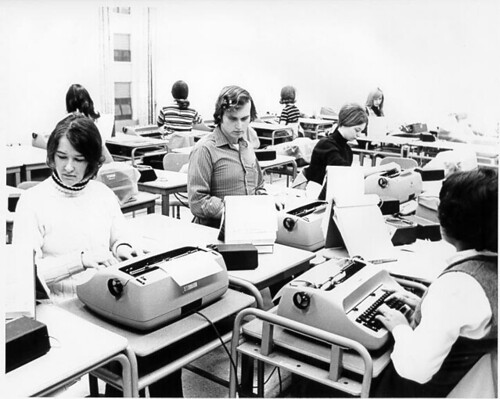
Typing Class, 1970s, originally uploaded by SinclairCommunityCollege.
Update the hair and clothing by a decade, and this would look like my high school typing class. Take away the power cords and regress a few decades, and this would look like my mom’s high school typing class. Now, typing classes have been replaced with computer applications courses, which teach touch typing in two to three months (e.g., http://south.sd41.bc.ca/depts/courses/cselection.htm – from the website of my alma mater), as by the time most students enter high school, they have been using a QWERTY keyboard attached to a computer for years, many without a lesson. This allows for a greater exploration of the creative applications of the technology far beyond the endless speed drills I spent doing in Typing 10. What change will the next innovation bring?
As a side note, I also considered the furniture and electrical systems that needed to change from the time when the first manual typewriter was introduced in typing classes, through electric typewriters, through a constant upgrade of computers. Education is, indeed, getting more expensive!
Hello! I am Tracy Gidinski. I will be teaching grades 6 and 7 at Taylor Park Elementary School in Burnaby, British Columbia. I have been teaching for 16 years, always focusing on grades 5 to 7 (and, for a four-year time, teaching a multiage 5/6/7 class). My preferred grade is combined 6/7. For the past few years, I have had my students create personal blogs and cooperative wikis, and am interested in further extending my students’ abilities to use technology to improve their literacy and thinking skills, which leads me to this course. This is my second MET course – I took ETEC 512 last year, and am hoping that the steep learning curve of taking a course online will be less steep this semester!
September 8, 2009 1 Comment
